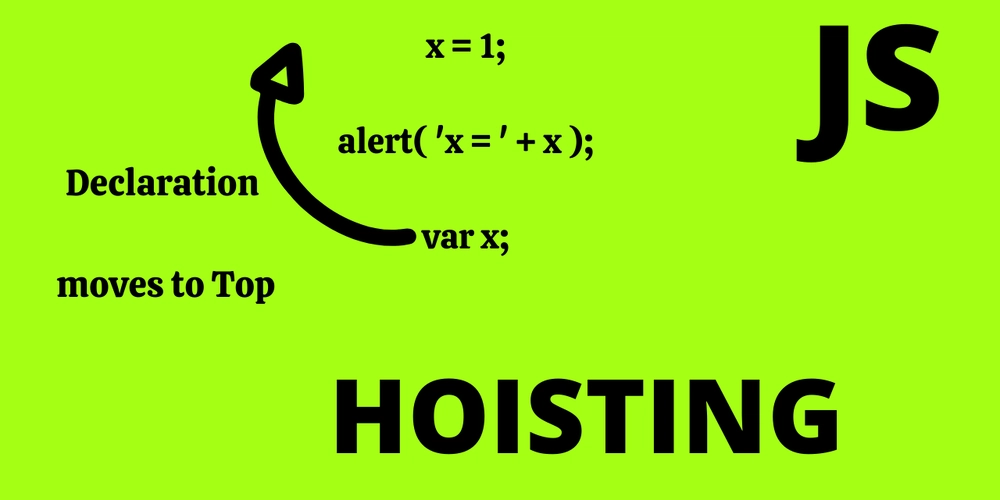Understanding JavaScript Hoisting with Examples
Title: Understanding JavaScript Hoisting with Examples What is Hoisting? In the world of JavaScript, hoisting is a fundamental concept that every developer must understand. To put it simply, hoisting is a JavaScript mechanism where variables and function declarations are moved to the top of their enclosing scope during the compile phase, before the code has been executed. Think of hoisting like a flag hoisted at the top of a pole. No matter where the flag is initially placed, it's eventually hoisted to the top. Similarly, regardless of where you declare functions or variables in your code, they are hoisted to the top of their scope. Let's consider this piece of code. console.log(myName); var myName = 'John Doe'; The output will be 'undefined' instead of a ReferenceError. This is because of the hoisting mechanism. When JavaScript is compiled, all variable declarations (not initializations) are hoisted to the top. The code is interpreted as follows: var myName; console.log(myName); //undefined myName = 'John Doe'; Function vs Variable Hoisting Function and variable hoisting behaviors differ slightly in JavaScript. For functions, both the declaration and the body are hoisted. Thus, you can call a function before declaring it in your code. hoistedFunction(); //Outputs: "Hello, I have been hoisted!" function hoistedFunction() { console.log('Hello, I have been hoisted!'); } In contrast, for variables, only declarations are hoisted, not initializations. So, if you try to use a variable before it's declared and initialized, you'll get 'undefined'. let & const behavior The hoisting mechanism works a bit differently with 'let' and 'const' compared to 'var'. While 'var' declarations are hoisted and initialized with 'undefined', 'let' and 'const' declarations are hoisted but not initialized. If you try to access a 'let' or 'const' variable before declaration, you'll get a ReferenceError because JavaScript doesn't initialize them with 'undefined' like it does with 'var'. console.log(myName); //ReferenceError: myName is not defined let myName = 'John Doe'; Interview Pitfalls Understanding hoisting is crucial not only for writing efficient code but also for acing technical interviews. Many interviewers ask questions related to hoisting to test a candidate's knowledge of JavaScript's inner workings. For instance, you might be asked why a particular piece of code returns 'undefined' instead of a ReferenceError, or why a function call before its declaration doesn't result in an error. Remember, JavaScript does not hoist initializations, only declarations. This is an easy detail to overlook, but it's crucial for understanding why your code behaves the way it does. In conclusion, hoisting is a unique and important feature of JavaScript that plays a crucial role in how the code is interpreted and executed. By understanding hoisting, you can write cleaner, more predictable code and avoid common bugs and pitfalls.

Title: Understanding JavaScript Hoisting with Examples
- What is Hoisting?
In the world of JavaScript, hoisting is a fundamental concept that every developer must understand. To put it simply, hoisting is a JavaScript mechanism where variables and function declarations are moved to the top of their enclosing scope during the compile phase, before the code has been executed.
Think of hoisting like a flag hoisted at the top of a pole. No matter where the flag is initially placed, it's eventually hoisted to the top. Similarly, regardless of where you declare functions or variables in your code, they are hoisted to the top of their scope.
Let's consider this piece of code.
console.log(myName);
var myName = 'John Doe';
The output will be 'undefined' instead of a ReferenceError. This is because of the hoisting mechanism. When JavaScript is compiled, all variable declarations (not initializations) are hoisted to the top. The code is interpreted as follows:
var myName;
console.log(myName); //undefined
myName = 'John Doe';
- Function vs Variable Hoisting
Function and variable hoisting behaviors differ slightly in JavaScript.
For functions, both the declaration and the body are hoisted. Thus, you can call a function before declaring it in your code.
hoistedFunction(); //Outputs: "Hello, I have been hoisted!"
function hoistedFunction() {
console.log('Hello, I have been hoisted!');
}
In contrast, for variables, only declarations are hoisted, not initializations. So, if you try to use a variable before it's declared and initialized, you'll get 'undefined'.
- let & const behavior
The hoisting mechanism works a bit differently with 'let' and 'const' compared to 'var'. While 'var' declarations are hoisted and initialized with 'undefined', 'let' and 'const' declarations are hoisted but not initialized.
If you try to access a 'let' or 'const' variable before declaration, you'll get a ReferenceError because JavaScript doesn't initialize them with 'undefined' like it does with 'var'.
console.log(myName); //ReferenceError: myName is not defined
let myName = 'John Doe';
- Interview Pitfalls
Understanding hoisting is crucial not only for writing efficient code but also for acing technical interviews.
Many interviewers ask questions related to hoisting to test a candidate's knowledge of JavaScript's inner workings. For instance, you might be asked why a particular piece of code returns 'undefined' instead of a ReferenceError, or why a function call before its declaration doesn't result in an error.
Remember, JavaScript does not hoist initializations, only declarations. This is an easy detail to overlook, but it's crucial for understanding why your code behaves the way it does.
In conclusion, hoisting is a unique and important feature of JavaScript that plays a crucial role in how the code is interpreted and executed. By understanding hoisting, you can write cleaner, more predictable code and avoid common bugs and pitfalls.







































































































































































![[The AI Show Episode 144]: ChatGPT’s New Memory, Shopify CEO’s Leaked “AI First” Memo, Google Cloud Next Releases, o3 and o4-mini Coming Soon & Llama 4’s Rocky Launch](https://www.marketingaiinstitute.com/hubfs/ep%20144%20cover.png)

































































































































![[DEALS] Sterling Stock Picker: Lifetime Subscription (85% off) & Other Deals Up To 98% Off – Offers End Soon!](https://www.javacodegeeks.com/wp-content/uploads/2012/12/jcg-logo.jpg)















































































































































_Olekcii_Mach_Alamy.jpg?width=1280&auto=webp&quality=80&disable=upscale#)
















































































































![M4 MacBook Air Drops to New All-Time Low of $912 [Deal]](https://www.iclarified.com/images/news/97108/97108/97108-640.jpg)
![New iPhone 17 Dummy Models Surface in Black and White [Images]](https://www.iclarified.com/images/news/97106/97106/97106-640.jpg)




































































































































